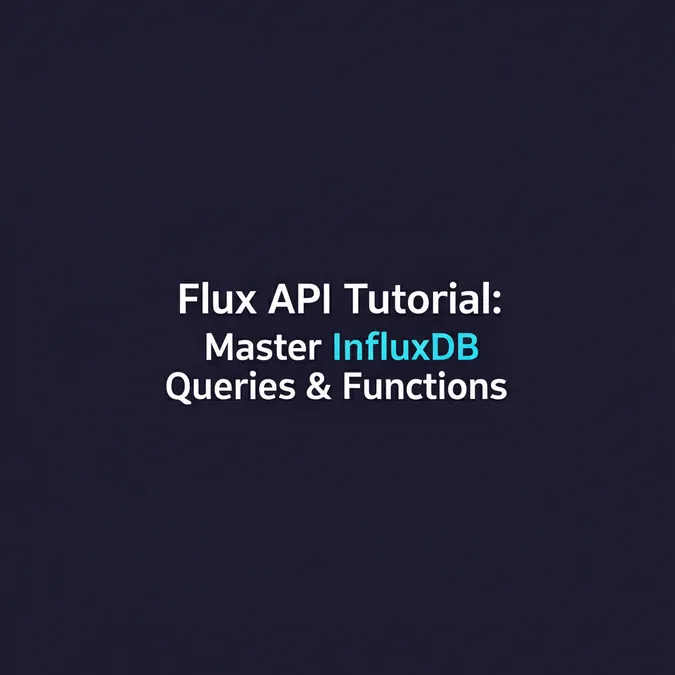Developer Offer
Try ImaginePro API with 50 Free Credits
Build and ship AI-powered visuals with Midjourney, Flux, and more — free credits refresh every month.
Flux API: Your Ultimate Guide for Time Series Data
Flux API: Your Ultimate Guide for Time Series Data
This guide offers a comprehensive introduction to the Flux API, empowering you to effectively query, process, and analyze time series data with InfluxDB.
Introduction: What is Flux API (and Why It Matters for Developers)?
The Flux API is primarily known as the interface to Flux, a powerful open-source functional data scripting and query language designed by InfluxData for working with time series data, especially within the InfluxDB 2.0 ecosystem and beyond. Think of it not just as a query language, but as a full-fledged data scripting environment that allows you to retrieve, shape, analyze, and act on your data with unprecedented flexibility. For developers working with metrics, events, sensor readings, or any data points indexed by time, understanding the Flux API is becoming increasingly vital. It's a key component for anyone looking to do more with flux for time series data.
It's important to distinguish the Flux API discussed here—focused on InfluxDB and time series data—from other APIs that might share the "Flux" name. For example, some APIs, like the FLUX.1 API by Black Forest Labs, are designed for specialized tasks such as image generation. While such tools are powerful in their creative domains, and sometimes accessible via platforms like imaginepro.ai which offer a range of AI-driven services, the Flux API we are exploring is specifically engineered for querying and manipulating time-stamped data within InfluxDB. Understanding what is flux api in influxdb 2.0 is the first step to leveraging its capabilities.
Core Concepts: Understanding the Flux Query Language
Flux isn't just an API endpoint; it's a language. The Flux query language has a unique syntax and execution model that makes it exceptionally well-suited for time series operations.
Basic Syntax and Structure of Flux Queries
Flux queries are typically composed of a series of functions chained together using the pipe-forward operator (|>). Each function takes a stream of tables as input, performs an operation, and outputs a stream of tables to the next function.
from(bucket: "my-bucket")
|> range(start: -1h)
|> filter(fn: (r) => r._measurement == "cpu" and r._field == "usage_system")
|> mean()
In this example:
from(): Specifies the data source (bucket).range(): Filters data by a time range.filter(): Narrows down data based on specific criteria (e.g., measurement, field).mean(): Calculates the average of the values in the_valuecolumn.
Understanding Pipes (|>) and Data Flow
The pipe-forward operator |> is central to Flux. It signifies that the output of the function on its left becomes the input for the function on its right. This creates a clear, readable data processing pipeline, making complex queries easier to construct and understand.
Getting Started with Flux API: A Practical Tutorial
Embarking on your flux api getting started journey is straightforward. While a full InfluxDB setup (either local or cloud) is assumed, let's dive into writing a basic query.
Writing Your First Flux Query: Hello, Time Series!
Let's assume you have a bucket named iot_sensors with data from a temperature sensor.
// Access data from the "iot_sensors" bucket
from(bucket: "iot_sensors")
// Limit data to the last 5 minutes
|> range(start: -5m)
// Filter for the "temperature" measurement and "room1" sensor
|> filter(fn: (r) => r._measurement == "temperature" and r.sensor_id == "room1")
// Keep only the time, value, and sensor_id columns
|> keep(columns: ["_time", "_value", "sensor_id"])
This query fetches temperature readings from room1 for the last 5 minutes. This is a basic illustration, but it showcases the core pattern of using the Flux API with common Flux functions.
Common Flux Functions You Need to Know
Flux has a rich library of functions. Some of the most frequently used include:
from(): Specifies the data source.range(): Filters records based on time.filter(): Filters records based on column values.group(): Groups records by specified columns.window(): Groups records by time and applies an aggregate.mean(),sum(),count(),median(): Common aggregate functions.pivot(): Rotates data from a row-wise to a column-wise orientation.
Exploring these functions is key to mastering the Flux query language. Many Flux API examples and tutorials focus on demonstrating these core capabilities.
Flux API vs. InfluxQL: Key Differences & When to Use Flux
For users familiar with InfluxDB 1.x, InfluxQL was the primary query language. The Flux API (and Flux language) offers several advantages:
| Feature | InfluxQL | Flux API (Flux Language) |
|---|---|---|
| Expressiveness | SQL-like, good for basic queries | Highly expressive, functional, Turing-complete scripting language |
| Joins | Limited support | Robust support for joins across measurements, buckets, etc. |
| Math Across Measurements | Difficult/Impossible | Straightforward |
| Data Shaping | Limited | Extensive data shaping and transformation capabilities |
| External Calls | Not supported | Can make HTTP requests, integrate with other data sources |
| Scripting | Not a scripting language | Designed for scripting complex data workflows |
When to use Flux API:
- You need advanced analytical functions or complex data transformations.
- You need to join data from different measurements or buckets.
- You are working with InfluxDB 2.0 and newer, where Flux is the primary language.
- You need to perform mathematical operations across different series.
- You want to build more sophisticated data processing pipelines directly within your queries.
While InfluxQL still has its place for simpler queries, the Flux API unlocks a new level of power for flux for time series data analysis.
Advanced Flux API Examples & Use Cases (Brief Overview)
The true power of the Flux API shines in more complex scenarios:
- Complex Filtering & Aggregation: Imagine calculating the 95th percentile of response times for services tagged with specific regions, but only during business hours. Flux handles this with relative ease.
- Data Transformation: Converting data from one schema to another, enriching data by joining it with metadata, or calculating deltas and rates are common tasks made simpler with Flux.
- Integrating with Client Libraries: You can execute Flux queries programmatically using client libraries for languages like Python, JavaScript, Go, and Java. For example,
how to use flux api with pythoninvolves using the InfluxDB Python client to send Flux queries and process results within your Python applications.
# Example: Python client (conceptual)
from influxdb_client import InfluxDBClient
# Configuration (ensure environment variables or direct values)
url = "http://localhost:8086"
token = "YOUR_INFLUXDB_TOKEN"
org = "your-org"
bucket = "your-bucket"
client = InfluxDBClient(url=url, token=token, org=org)
query_api = client.query_api()
flux_query = '''
from(bucket: "your-bucket")
|> range(start: -1h)
|> filter(fn: (r) => r["_measurement"] == "system")
|> filter(fn: (r) => r["_field"] == "load1")
|> yield(name: "mean")
'''
tables = query_api.query(flux_query, org=org)
for table in tables:
for record in table.records:
print(f"Time: {record.get_time()}, Value: {record.get_value()}")
client.close()
Flux API Documentation & Learning Resources
To dive deeper into the Flux API and its capabilities, the official documentation is indispensable:
- InfluxData Flux Documentation: https://docs.influxdata.com/flux/v0.x/ (Always refer to the latest version)
- InfluxDB Client Libraries: https://docs.influxdata.com/influxdb/v2.0/api-guide/client-libraries/ (Adjust version as needed)
Community forums and GitHub repositories related to InfluxDB and Flux are also excellent places to find solutions and ask questions.
Conclusion: Empowering Your Data Workflows with Flux API
The Flux API and its underlying query and scripting language represent a significant leap forward for time series data management. By providing a flexible, powerful, and expressive way to interact with InfluxDB, Flux empowers developers to build sophisticated data analysis and automation workflows. Whether you're performing complex aggregations, transforming data on the fly, or integrating with external systems, mastering the Flux API will undoubtedly enhance your ability to extract maximum value from your time series data. Start exploring its features today and unlock new possibilities for your data-driven applications.
Compare Plans & Pricing
Find the plan that matches your workload and unlock full access to ImaginePro.
| Plan | Price | Highlights |
|---|---|---|
| Standard | $8 / month |
|
| Premium | $20 / month |
|
Need custom terms? Talk to us to tailor credits, rate limits, or deployment options.
View All Pricing Details

